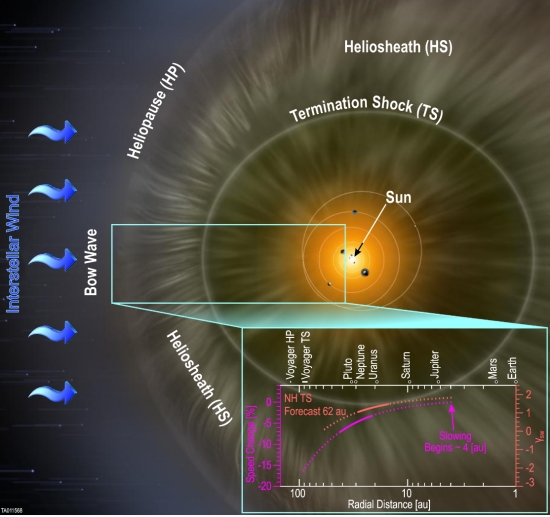It should be evident why getting information about the solar wind is useful for future deep space missions. Concepts like the electric sail, recently discussed in these pages, and various forms of magnetic sail using superconductors all rely on hitching a ride on this fast-moving stream of particles and magnetic fields emanating from the Sun. A key problem has been tracking the solar wind’s behavior in space through changing solar cycles as we get to increasingly large distances from the Sun, but fortunately we do have a few assets at system’s edge.
New Horizons’ Solar Wind Around Pluto (SWAP) instrument continues to return data useful not only for Solar System science but also for understanding how the outflow from the Sun could affect spacecraft in the Kuiper Belt. Of interest here are the spacecraft’s measurements of ‘interstellar pickup ions’ in the outer heliosphere, a region through which only the two Voyagers and the two Pioneers before them have previously traveled. Pickup ions emerge when neutral material from the interstellar medium (ISM) enters the Solar System, to become ionized by the Sun’s light or by charge exchange interactions with solar wind ions.
Heather Elliott is a staff scientist at the Southwest Research Institute, deputy principal investigator of the SWAP instrument and lead author of a new paper on this work:
“Previously, only the Pioneer 10 and 11 and Voyager 1 and 2 missions have explored the outer solar system and outer heliosphere, but now New Horizons is doing that with more modern scientific instruments. Our Sun’s influence on the space environment extends well beyond the outer planets, and SWAP is showing us new aspects of how that environment changes with distance.”
Indeed. And the more eyes on the target, the better. When the Voyagers moved through the outer heliosphere, the Sun was in a very active solar cycle. New Horizons now moves through a mild solar cycle, with SWAP measuring the low flux of interstellar pickup ions with what the mission’s team describes as “unprecedented time resolution and extensive spatial coverage.” Bear in mind that we now have just one spacecraft measuring the solar wind beyond Mars, so New Horizons is our only source for the interactions between the solar wind and interstellar material.
One effect now confirmed by SWAP is that the ionization of interstellar material causes the solar wind to slow and heat up in response. Here we can draw on other spacecraft: The SWAP data can be compared to the solar wind speed measurements from 21 to 42 AU from both the Advanced Composition Explorer (ACE) and Solar TErrestrial RElations Observatory (STEREO). New Horizons was able to confirm the slowing of the solar wind evident at a distance of 21 AU (a little over the distance of Uranus from the Sun), and to show that the solar wind measured still slower, by 6-7 percent, between 33 and 42 AU.

Image: The SWAP instrument aboard NASA’s New Horizons spacecraft has confirmed that the solar wind slows as it travels farther from the Sun. This schematic of the heliosphere shows the solar wind begins slowing at approximately 4 AU radial distance from the Sun and continues to slow as it moves toward the outer solar system and picks up interstellar material. Current extrapolations reveal the termination shock may currently be closer than found by the Voyager spacecraft. However, increasing solar activity will soon expand the heliosphere and push the termination shock farther out, possibly to the 84-94 AU range encountered by the Voyager spacecraft. Credit: Southwest Research Institute; background artist rendering by NASA and Adler Planetarium.
It’s instructive to see how the boundary where the solar wind slows to less than the sound speed as it approaches the interstellar medium moves over time, a malleable feature indeed. Voyager 1 crossed this ‘termination shock’ in 2004 at 94 AU, with Voyager 2 crossing in 2007 at 84 AU. The current lower levels of solar activity presage a termination shock that is now even closer to the Sun. We’ll still be receiving New Horizons data when the spacecraft crosses the termination shock in the mid-2020s. As solar activity increases in its regular cycle, the shock may be pushed back to 84-94 AU by the time New Horizons is able to reach it.
The paper is Elliott et al., “Slowing of the Solar Wind in the Outer Heliosphere,” Astrophysical Journal Vol. 885, No. 2 (11 November 2019). Abstract.



We tend to think of the solar wind as a constant, gentle breeze. This evidence shows that the breeze lessens as it reaches the outer system. It should also lessen a little due to the solar gravitational attraction). CMEs, deflections around planets with and without magnetic fields should result in gusts and changing wind directions. At some point in the future, we may map these winds in detail, initially like the old trade winds maps for sailing ships, and then in detail like our weather maps.
Such maps will improve our use of ships driven by interacting with the solar wind, even if that proves a temporary “age of electric sail”. I would hope that it might still offer interest for sailing races, much like Clarke’s “The Wind from the Sun” suggested for photon sails.
Rig the storm sail, there’s is a Coronal Mass Ejection on our stern!